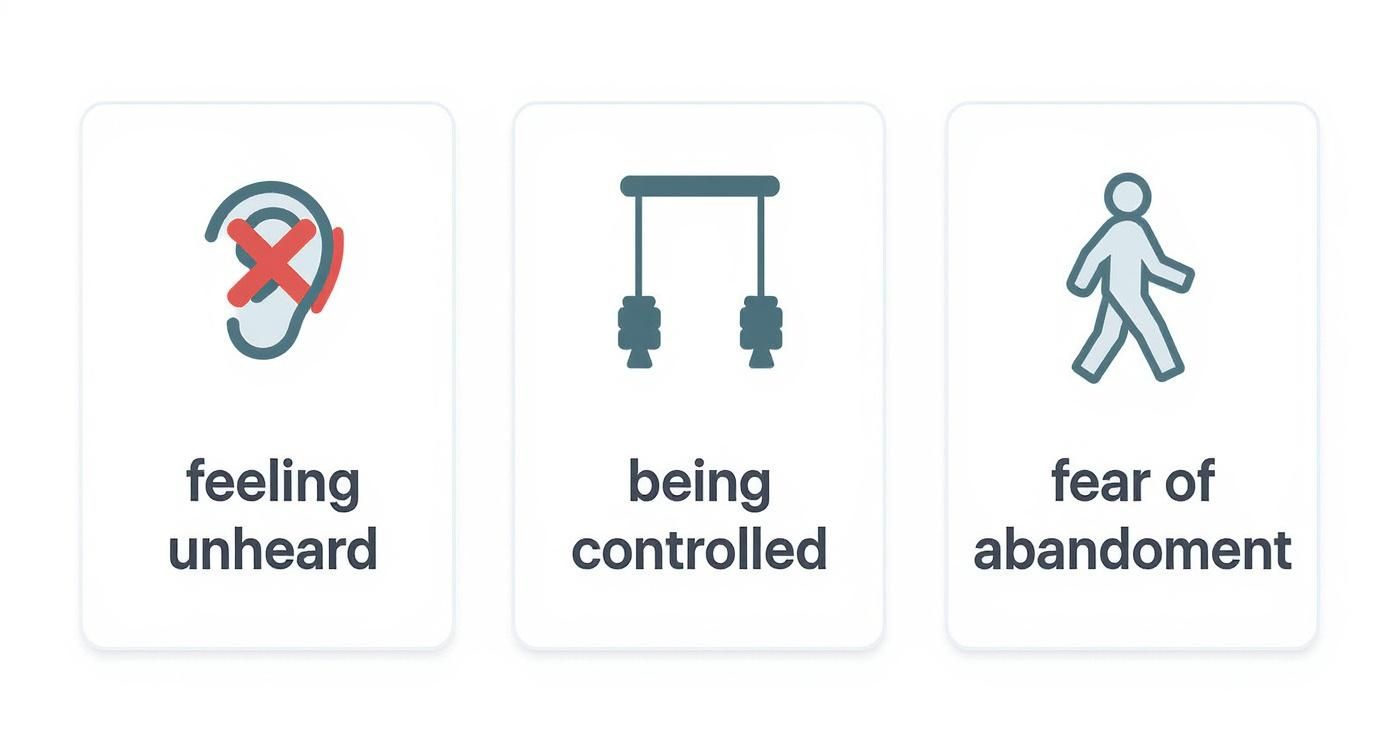If you want to stop fighting in your relationship, you have to make a crucial shift. Stop trying to win the argument and start trying to understand the real reason you're fighting in the first place.
It's almost never about the dishes or being five minutes late. It's about the unmet emotional needs simmering just below the surface. Once you can recognize the hidden feelings that trigger these conflicts, you can finally break the cycle before it spins out of control.
Understanding the Real Reasons Couples Fight

It’s a persistent myth that frequent fighting is a sure sign of a doomed relationship. More often than not, those recurring arguments are just smoke signals, pointing to something important that needs attention. The fight about who should take out the trash isn't really about garbage—it's about one person feeling unappreciated, unsupported, or invisible.
So many couples get stuck in what therapists call a conflict cycle. Think of it as a predictable, frustrating pattern: a trigger leads to an immediate emotional reaction, which then spirals into the same old argument. Recognizing this cycle is the first, most powerful step toward breaking it.
The Anatomy of a Fight
A conflict cycle usually has a few key stages. It all kicks off with a trigger—an action or a comment that pokes at a sensitive emotional spot. This isn't just a random annoyance; it's something that connects to a much deeper fear or an old wound.
For example, a partner coming home late without a quick text might trigger a deep-seated fear of being forgotten or feeling unimportant. The initial reaction isn't logical; it's purely emotional. That raw feeling then fuels a defensive or accusatory response, which, of course, prompts a similar reaction from the other partner.
Before you know it, you're locked in that familiar, painful dance. Seeing this pattern is a game-changer because it helps you shift the focus from blaming your partner's behavior to understanding your own internal experience.
Moving Beyond Surface-Level Disagreements
To truly learn how to stop fighting, you have to dig deeper. You need to look past the what of the argument and start exploring the why. The most common fights almost always mask fundamental emotional needs that are going unmet.
Here are some of the real drivers behind those common fights:
- Feeling Unheard or Dismissed: This is a big one. It happens when one partner feels like their opinions, feelings, or perspective are constantly being ignored. The argument becomes a desperate, last-ditch attempt to finally be acknowledged.
- Feeling Unappreciated: Resentment builds quietly when one person feels like all their efforts go completely unnoticed. A fight over a small, forgotten chore can suddenly become a massive explosion about feeling taken for granted.
- A Fear of Abandonment: For someone with this underlying fear, a partner's simple need for space or a night out with friends can feel incredibly threatening. This can trigger clingy or controlling behavior that inevitably leads to conflict.
- Feeling Controlled or Suffocated: On the flip side, a partner who deeply values their autonomy might feel trapped by too many demands or expectations. They'll often push back by starting arguments to create much-needed distance.
The goal isn't to eliminate conflict entirely—that’s just not realistic for any relationship. The real objective is to change how you engage with it. By understanding the root causes, you can transform a battle into a powerful opportunity for connection and deeper understanding.
This foundational awareness is the most powerful tool you have. When you can see that a fight is really a cry for security, respect, or appreciation, you can choose to respond with empathy instead of defensiveness. This is the first and most significant step toward lasting change and a more peaceful partnership.
Figuring Out Your Personal Conflict Triggers
Have you ever been in the middle of a perfectly normal conversation, and then suddenly, one little phrase or even just a certain tone of voice makes your blood boil? That instant spike of anger or hurt is a dead giveaway you’ve just tripped over a personal conflict trigger.
Think of these triggers as emotional raw spots, usually tied to something in our past. When they get poked, they set off a defensive reaction that’s often way bigger than the current situation really calls for.
Knowing what sets you off is the first, most critical step toward breaking the cycle of constant fighting. It's like having a map of your own emotional minefield. Without it, you and your partner are just going to keep stumbling onto the same explosives by accident, sparking the same arguments again and again.
It All Starts With Looking Inward
Getting to the bottom of your triggers means you have to play detective with your own emotions. The point here isn't to blame your partner for "pushing your buttons." It's about figuring out why those buttons are there in the first place.
Your personal history, the relationships you’ve had before, and the way you were raised—all of it has shaped your unique set of sensitivities.
This kind of self-awareness is a game-changer. Once you can spot a trigger as it’s happening, you create a tiny but powerful gap between the stimulus and your knee-jerk reaction. In that little bit of space, you find the power to choose a different path.
A trigger isn't just something you don't like. It's an emotional reaction that feels completely out of proportion to what’s actually happening. Nailing that disconnect is the key to getting back in the driver's seat.
Common Triggers and What They Feel Like
While everyone's triggers are a little different, most of them tend to fall into a few common buckets. See if any of these sound familiar:
- Feeling Controlled: Does a bit of advice from your partner land like an order? This trigger often makes you want to dig in your heels and fight back just to prove you're in charge of your own life.
- Feeling Ignored or Unheard: This one pops up when you're trying to say something important, but your partner seems checked out, changes the subject, or waves away your feelings. It can make you feel completely invisible.
- Fear of Abandonment: If your partner asking for a little space or a night out with friends sends a wave of panic through you, this could be your trigger. It often leads to clingy behavior or picking a fight to pull them back in.
- Feeling Criticized or Judged: A simple comment about a mistake you made can feel like a full-blown character assassination, kicking up old feelings of shame or not being good enough.
And let's be clear, these triggers don't just show up in our love lives. Workplace conflict is a daily grind for millions, with 85% of employees saying they deal with it regularly, often because of the very same emotional tripwires.
One study found that the average employee wastes 2.8 hours per week on disputes, usually fueled by clashing egos and high stress. You can dig into these workplace conflict statistics to see just how universal this stuff is. Learning to spot your triggers gives you an edge everywhere, not just at home.
Effective Communication That Prevents Fights
Good communication is your best defense against getting stuck in that frustrating cycle of having the same fight over and over. It's not about winning an argument; it's about learning how to stop fights before they even get started.
This all begins with a huge mental shift: moving from a "me vs. you" mindset to an "us vs. the problem" mindset. And one of the most powerful ways to do that is by changing the way you talk about your feelings.
Using 'I' Statements to Share Feelings
Let's talk about the 'I' statement. It’s a game-changer. Seriously. This simple tweak in how you phrase things can completely flip the script on a tough conversation.
An 'I' statement keeps the focus on your emotional experience, not on what your partner did wrong. It’s the difference between saying, "You never listen to me," which immediately sounds like an attack, and saying, "I feel unheard when we talk about this."
See the difference? The first one makes your partner defensive. The second one invites them to understand your perspective. It’s not about being soft; it's about being smart and effective.

These core feelings—feeling unheard, controlled, or abandoned—are often lurking beneath the surface of our biggest fights. That's why being able to talk about them clearly is so critical.
Practicing Active Listening and Validation
Of course, communication isn't a one-way street. While 'I' statements help you express yourself, active listening is how you show your partner they're actually being heard. And I don't just mean staying quiet while they talk.
It means giving them your full, undivided attention.
- Put your phone down. All the way down.
- Make eye contact. Show them you're locked in.
- Reflect back what you hear. Say things like, "So it sounds like you're feeling really frustrated because…" This isn't just repeating words; it's proving you get it.
Validation is the next step. This is huge. It means acknowledging that your partner's feelings are valid, even if you don't agree with their reasoning. A simple, "I can see why you would feel that way," can instantly diffuse tension.
Acknowledging your partner's feelings doesn't mean you are surrendering or admitting fault. It simply means you respect their emotional experience, which is a powerful way to de-escalate tension.
Fights often start because of small, destructive communication habits we don't even realize we have. By consciously swapping those out for more constructive ones, you're building a stronger foundation.
Destructive vs Constructive Communication Patterns
| Destructive Pattern (What to Avoid) | Example | Constructive Alternative (What to Do) | Example |
|---|---|---|---|
| Blaming | "You always leave a mess." | Using 'I' Statements | "I feel stressed when the kitchen is messy." |
| Generalizing | "You never help around the house." | Being Specific | "Could you help me with the dishes tonight?" |
| Invalidating | "You're overreacting. It's not a big deal." | Validating Feelings | "I can see this is really upsetting you." |
| Defensiveness | "It's not my fault! You…" | Taking Responsibility | "You're right, I should have helped more." |
Switching from destructive to constructive patterns takes practice, but it's one of the most important things you can do for the health of your relationship.
If you want to keep building these skills, our guide on how to communicate with your partner has even more strategies. For a deeper look at why these issues pop up, you might find resources on understanding communication breakdown in relationships really helpful.
Ultimately, mastering these skills is how you stop fighting for good. It's about choosing connection over conflict and building a partnership based on mutual respect.
In-the-Moment Strategies to De-escalate Arguments

When emotions are running hot, your logical brain pretty much clocks out. It's just how we're wired. Trying to solve the root of the problem when you're both seeing red is like trying to do complex math during a fireworks show—it’s just not going to happen.
Your immediate goal isn’t to fix everything. It's to stop the emotional bleeding. You need a game plan to bring the temperature down before more damage is done.
The single most powerful tool you have mid-fight is the strategic pause. This isn't about storming off or hitting them with the silent treatment. Think of it as a mutually agreed-upon timeout to let the emotional storm pass so you can both think clearly again.
Calling a Respectful Timeout
Knowing how to gracefully stop a fight dead in its tracks is an absolute game-changer. It gives you the power to prevent saying things you'll instantly regret and lets you come back to the conversation with a cooler head. The trick is to frame it as a shared need, not a personal escape hatch.
A good timeout looks something like this:
- Agree on a signal beforehand. It can be a simple phrase like "I need a pause" or even a quick hand gesture you both recognize.
- Set a specific return time. Don't just leave it hanging. Saying, "Let's take 20 minutes and meet back here" shows you're committed to resolving this, not abandoning it.
- Use the time wisely. This isn't for stewing in your anger. Go for a walk, put on some calming music, or just do some deep breathing exercises. The goal is to calm your nervous system, not rehearse your next argument.
Taking a timeout isn't a sign of weakness; it's a sign of emotional intelligence. It's a mutual agreement to protect the relationship from the heat of the moment, allowing you to address the issue constructively once emotions have settled.
Once you’ve taken that break, you can re-engage from a much calmer place. Sometimes just a simple grounding technique helps. Feel your feet on the floor. Focus on your breath. It sounds small, but it pulls you out of that reactive, emotional lizard brain and back into your body.
Using Phrases That Defuse Tension
The words you choose can either be gasoline on the fire or a bucket of water. Having a few go-to phrases in your back pocket can completely shift the dynamic of a heated argument. They aren't magic words, but they signal a change from attack mode to "we're in this together" mode.
Try out some of these powerful softeners:
- "You're right." (Even if you only agree with one tiny part of what they said, it’s a start.)
- "Help me understand your side of this."
- "I can see why you feel that way."
- "This is important to both of us. Let's figure it out together."
Phrases like these show you're actually listening and that you value their feelings, which is often what your partner is really looking for underneath all the anger. It's also a great lead-in to figuring out how to apologize sincerely once things have cooled off, a critical skill for repairing the connection.
How to Build a More Peaceful Relationship Long-Term

Knowing how to hit the pause button during a heated argument is one thing. Building a relationship where those arguments are less frequent and far less explosive is the real game-changer. This doesn't happen by accident; it takes intentional, proactive work when things are calm.
Think of it like putting money into a savings account. Every positive interaction, every moment of connection, builds up an "emotional bank account." When tough times hit—and they will—you have a reserve of goodwill to draw from. It's the best kind of preventative maintenance for your partnership.
Make Time for Regular Relationship Check-Ins
One of the most powerful habits you can build is the regular relationship check-in. This isn’t a time to air grievances or rehash old fights. It’s dedicated, low-stakes time to simply connect.
Set aside 20 minutes every Sunday night, grab a cup of tea, and just talk. The goal is to touch base on how things are feeling before small irritations snowball into major conflicts.
You could ask questions like:
- "How are you feeling about us this week?"
- "Was there a moment I made you feel really loved?"
- "Is there anything you need from me in the coming week?"
These chats keep the lines of communication wide open and stop resentment from quietly taking root. Many couples find it useful to look into different relationship therapy techniques to give these check-ins a little more structure and make them even more effective.
Create Your "Rules of Engagement"
Just as important is sitting down together—when you're both calm and happy—to create a set of "rules of engagement" for disagreements. This is your shared pact for how you'll handle conflict when it inevitably pops up.
The point is to create a shared agreement that protects the relationship, even when you're angry. This completely shifts the dynamic from you vs. me to us vs. the problem.
Your rules might look something like this:
- No name-calling or character attacks. Ever.
- We stick to the current issue. No bringing up that thing from three years ago.
- Either of us can call a timeout if we're feeling overwhelmed, no questions asked.
This idea of having a formal process isn't just for couples. The global market for conflict resolution was recently valued at a staggering USD 8.79 billion, which just goes to show a universal truth: structured approaches work. They help us stop fighting and start solving problems together.
Of course, long-term peace also comes from within. It’s about cultivating gratitude and resilience in your partnership to build a foundation that can weather any storm. At the end of the day, a peaceful partnership is a living thing, nurtured by connection, communication, and a whole lot of mutual respect.
Tackling Your Toughest Conflict Questions
Trying to put new relationship skills into practice can feel clunky and awkward at first, and it almost always brings up some tricky questions. When you're working to untangle years of ingrained argument habits, hitting a few snags is completely normal. Here are some clear, real-world answers to the challenges I see couples run into most often.
What If My Partner Won't Try These Things?
This is easily one of the most common—and most painful—situations couples face. You can't force your partner to change. It's a hard truth, but accepting it is the first step. What you can do, however, is change your own behavior, which has a funny way of shifting the entire dynamic of the relationship.
Start by modeling the communication techniques yourself. Stick to ‘I’ statements, genuinely practice active listening (not just waiting for your turn to talk), and call for a respectful timeout when you feel yourself getting overwhelmed. Your personal commitment to de-escalation can single-handedly lower the emotional temperature.
When you consistently show up to disagreements in a new way, it can invite a different response from your partner over time. The key is to focus on the only thing you have any real control over: your own actions and reactions.
Remember, the goal isn't to "fix" your partner; it's to improve the dance between you. When one person changes their steps in a familiar dance, the other person almost always has to adjust theirs, too.
How Do I Manage My Own Anger in the Moment?
Getting a handle on your own anger is absolutely critical before you can even think about resolving a conflict constructively. When you feel that familiar heat rising in your chest, your first and only job is to get your own nervous system back under control.
Try these simple grounding techniques right in the middle of a tense moment:
- Breathe first. Take three deliberately slow, deep breaths. Really focus on the physical sensation of the air filling your lungs and then leaving your body.
- Engage your senses. Quietly name five things you can see, four things you can physically feel (your feet on the floor, the fabric of your shirt), three things you can hear, two you can smell, and one you can taste. This is a classic for a reason—it works.
- Take a literal step back. Just creating a few feet of physical distance can give you a surprising amount of emotional space to think.
These aren't about suppressing your anger. They're about interrupting your body's "fight-or-flight" response long enough for your rational brain to come back online. This is how you shift from reacting impulsively to communicating effectively.
When Should We Consider Therapy?
Knowing when to call in a professional is a sign of strength, not failure. If you find yourselves stuck in the same painful, destructive cycles no matter how hard you try, a good therapist can be an invaluable guide.
It might be time to seek help if:
- Arguments frequently escalate into name-calling, yelling, or emotional abuse.
- One or both of you feel consistently unheard, resentful, or just plain hopeless about the relationship.
- You keep having the same exact fight over and over again with no real resolution.
- You simply can't seem to talk about sensitive topics without the conversation blowing up.
Think of a couples therapist as a neutral, skilled referee. They can help you see the patterns you're blind to, get to the real root of your conflicts, and teach you strategies tailored specifically for you and your partner to build a more secure and peaceful connection.
At Poke Match, we're all about helping you build stronger, healthier connections with practical advice and expert insights. For more guidance on navigating the complexities of modern relationships, explore our resources at https://poke-match.com.
